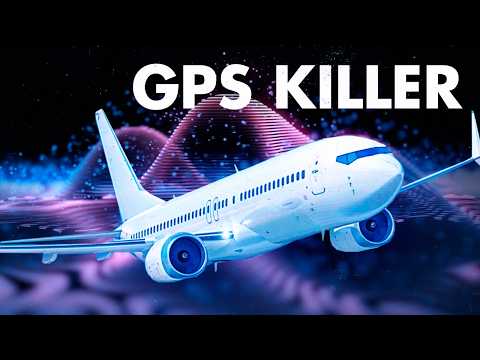THIS Technology Could REVOLUTIONIZE Airline Safety!

- What is quantum navigation and what does it have to do with the aviation industry? Well, as it turns out, this technology could be what we need in order to solve the very real and serious problems of GPS jamming and spoofing. Stay tuned. (playful chime) A few years ago, a clever team of scientists at the College of Computer and Information Science at Northeastern University in Boston decided to test a hypothetical question. Could someone's movements be tracked without their knowledge by someone using nothing but the accelerometer and gyroscope in their phone? At the time, phones had safeguards around how installed apps could access sensors like the GPS, but other sensors like the accelerometer and the gyroscope or the compass didn't have those same safeguards.
The theory which the scientists were testing was that if you are walking at a steady pace on one street, then turn right onto another and then turn a few more times, and if the city you're in is already known, well then those parameters would quickly form a pattern that only fits one possible location. Your location. And worryingly, the team also found that this actually worked even with a fairly basic accelerometer, like the one in your phone, you could actually be tracked.
Now, this research is 10 years old, so all of this was possible even with the sensors phones had 10 years ago. But the fact that this is old news also means that phone makers also know about this now, so today we have better control over most of our phone's sensors. But this shows us just how useful a gyroscope can be, and that is very relevant to this story since the devices we are going to look at today use essentially the same technology. Of course, what we use in aviation is a few orders of magnitude more accurate, but as it turns out, there is still a lot of room for improvement in it. Now, to understand the significance of these systems, we need to first talk a little bit about the different systems that we already use today in order to help us navigate in the air. As I'm sure most of you know, our default navigation system these days is GPS.
It's a very precise system, who normally lets us know our position down to an accuracy of a few meters, which is pretty good for nearly everything that we need to do. But of course, the GPS is only the latest in a very long line of navigational systems. Broadly speaking, we pilots have historically used five ways to navigate the skies.
The first one is the simplest, looking out through the window and correlating features and landmarks with what we have on our map, and this is referred to as VFR or visual navigation. This is one of the very first thing that you will learn when you start your flight training, because without that, it's very hard to do anything in the beginning. The second method is known as dead reckoning, and that requires some instruments, a compass for our heading, something to tell us our speed, and a stopwatch. On top of that, we also need a way to figure out how the winds are making our heading different from our actual track, which makes the process a little bit more challenging. To use this method, we need to know our starting position, and then we pre-plan a route with specific waypoints.
So to reach the first waypoint, we need to know how to steer the aircraft to get there, our speed, and the time that it will take. And then, once we reach that point, we turn towards the next waypoint, and then so on. By the way, does this method seem a little bit familiar? Well, that's probably because, conceptually speaking, dead reckoning isn't far off from what those Northeastern Universities scientists tested with phone gyroscope data. And that's worth remembering here.
Anyway, this method of navigation can be much more accurate than you might think. The only catch is that errors with this method are cumulative, so the more waypoints you add, and the more time it takes, the more chances you have to drift away from each waypoint. Our next method is navigating using the stars, or celestial navigation. This method is obviously much older than aviation itself, since ship crews have been using it for centuries.
It works by selecting a specific star, and then noting its angle over the horizon. That angle, the time of day, and the direction of the star, can then give us our approximate position. Older airliners, including the Vickers VC10s, actually included equipment for this, and even though it isn't remarkably accurate, at least its accuracy shouldn't worsen over time, so it's not cumulative. Now, you still wouldn't want to use this data to start an approach, for example, but there is a technique to it, and if you do it right, it will tell you roughly where you are when you're crossing an ocean, for example, which was good enough if you go back half a century. The fourth navigation method is what we call radio navigation.
In its original form, this involved the use of ground-based radio navigation beacons, and depending on their specific type and our equipment on board, these beacons can give us a direction to follow to reach the beacon, or a specific bearings to and from the beacon, in the case of a VOR. Back in the days, there were also long-range navigational systems based on navaids like Decca and Loran C, but that have all but disappeared from the use in aircraft today. Over time, even the NDB and VOR beacons have also started falling out of fashion, but they are still around and they form the backbone to most arrival and departure procedures, including holdings and airways. Now, we also use instrument landing systems for most approaches, which is another form of radio navigation, so this practice is still what new IFR and instrument pilots will spend most of their training time on. The same also goes for GPS. GPS satellites are obviously not ground-based, and they send out a very different kind of radio signal, which basically just tells the receiver where the satellite is.
But with the signals from multiple satellites, we can pinpoint our location with great accuracy. So in short, radio navigation has been successfully used for a long time, and have lately been improved to systems like the ILS and the GPS. But the same improvements and expansion could also soon hit our fifth navigation method, inertial navigation. And if that happens, this change could truly transform the way that we fly, eliminating many of the risks of GPS, and I will explain how after this. With the lovely travel season now in full swing, I want to give a real shout out to today's sponsor NordVPN. Nord is a real must-have tool, not only to bypass pesky geo-restrictions to access your favorite content, but also to surf the web safely and securely.
Whenever I'm out traveling, and that's a lot, I either use Nord to connect to a server back home, so websites shows up in my own currency, everything looks familiar, and I don't get random calls about any activity from my bank, or I use Nord to virtually move around, to check for better prices on hotels, rental cars, or even flights. Just make sure to clean your cash before doing that, pro tip. On top of that, NordVPN provides all sorts of cybersecurity tools, which are definitely helpful in today's world, and if you want access to this awesome tool yourself, then go to nordvpn.com/mentournow. This will give you four free months when you sign up for the two-year deal, and there might also be some other perks in there that it's worth checking out. So once again, nordvpn.com/mentournow. A huge thank you to Nord for sponsoring this video.
Now let's continue. One way to understand how inertial navigation systems, or inertial reference systems work, is to think of them as kind of a dead reckoning system, but one that is completely automated and extremely accurate. Instead of manually planning a flight with a series of waypoints, and then timing and flying specific tracks at particular speeds, an inertial navigation system works by tracking even the tiniest turn, every change in speed, and every other slight movement, to calculate where we are continuously. So how is this possible then? Well, these systems use very precise accelerometers and gyroscopes, to measure and add up all of these changes to movements and accelerations.
Earlier versions used rotating masses as gyroscopes, and each unit had three such masses, one for each of the three axes, in order to measure rotation in all three dimensions. In aircraft we refer to these dimensions as pitch, yaw and roll, and on top of the gyros, there were also a linear accelerometer for each of these axes to measure acceleration in each direction. The systems include sensors that measure the speed of the rotating masses, and detect every minuscule change in them, and these early systems were sometimes called carousels, after the popular Delco Carousel model series. More recent types of gyroscopes include those miniaturized sensors that can be integrated into printed silicon chips, used in your phone, drones or RC helicopters, but those are less accurate than what we need for commercial aviation. So what we now use in our airliners, instead of those carousels, are devices called ring laser gyroscopes, and they do the same job, but they rely on a pair of laser beams instead of rotating masses.
This is how they work: a single laser beam is split into two, with each of the two halves bouncing off a set of mirrors. Those mirrors are usually arranged in a triangle or a rectangle, so that the beams eventually both reach the same sensor. With no movement, the two beams should arrive at that sensor at the same time, but if there is even the tiniest rotation along the axis of the ring laser gyro, well then one of the two laser beams will have to move a shorter distance, and therefore arrive at the sensor a tiny fraction of a second before the other laser beam. The sensor will detect this difference as a kind of interference pattern between the two laser beams, and by interpreting that pattern, the device will be able to measure the rate of rotation that occurred. Because the ring laser gyro has no moving parts, it is incredibly accurate so accurate, in fact, that when we turn on the IRSs in an airliner and the system aligns, it actually starts by measuring the acceleration caused by the rotation of the earth.
And it can measure that with such good accuracy, that it can figure out how far away the aircraft is from the equator, or in other words, its latitude, since if the aircraft is close to the equator, the angle of rotation and its angular velocity will be different than it was nearer to the poles. Detecting the earth's rotation also means that the system can find which way the north pole is. And by the way, all this means that IRSs wouldn't really work if the earth was flat. Just saying. But as advanced as ring laser gyros are, some aircraft, especially military ones and space vehicles, are now using an improved version of the same system called fiber optic gyros, or FOG. Like the ring laser gyro, the newer system splits a laser beam and then sends it off to a sensor to two different directions.
But instead of bouncing off the beams of mirrors, the laser travels in pairs of fiber optic tubes, and crucially, these fiber optics can be wound really tight, so each one can be hundreds of meters long. The longer distances that the laser beams travel mean that these things have better accuracy than laser ring gyros, and they're also smaller and lighter, which is why space vehicle designers like them a lot. The downside of ring laser and fiber optic gyros is that just like with manual dead reckoning, their errors are cumulative. As time passes, they drift more and more, either because of imperfections in the mirrors for the ring laser gyros, or imperfections in the fiber optic tubes. But the beauty of both ring laser and fiber optic gyros is that they are fully on-board contained systems, and once you give them their initial position and align them, they don't need any external inputs at all. And that means that neither version can be jammed or spoofed, which is why such systems remain extremely valuable especially today.
A while back I made another video explaining why GPS jamming and spoofing are becoming more and more serious problems in aviation today. GPS jamming is when someone uses a system which essentially blocks us from being able to use GPS by jamming the satellite signals. This is a nuisance, but if something like that happens, because we are close to a war zone or for some other reason, well then we would just revert to inertial or radio navigation and just continue flying.
Now jamming is rare, and if we know that we might fly close to an area where it might happen, we can also brief and plan for it accordingly. GPS spoofing on the other hand is rarer and potentially much more problematic. Spoofing is when the aircraft systems are tricked into thinking that we still have GPS available because the spoofing signal is imitating the real GPS transmission, but it's showing us a false actual position. This can take us away from our intended track if we don't notice it, and it's therefore much more serious, but there are still ways to deal with it.
In many aircraft, the systems we have on board are clever enough to figure out that the GPS is compromised, because the aircraft notices that we would need to fly at impossible speeds to move between the fake positions that the spoof GPS signals are indicating. But remember how the IRS system can sometimes build up errors over time? Well, because of that, the IRS system sometimes uses the GPS position to eradicate those errors, and if that happens while the GPS system is spoofed, well then this can corrupt the IRS system as well. And on top of that, the spoofing can temporarily also interact with other systems in the aircraft, which can cause a very nasty set of warnings and things for us pilots. - [GPWS] Terrain ahead. Pull up! Terrain ahead. Pull up! That's what happened to the crew of an Airbus A320 in a video that I showed a few months ago.
Their ground proximity warning system suddenly gave them pull up commands when they were cruising at 37,000 feet. Now that was obviously wrong, so the crew didn't react to it, but imagine if that same thing would have happened at a lower altitude or just prior to the approach. Another crucial detail to understand here is that the inertial reference system isn't used only for navigation. Along with data from the aircraft's pitot probes and static ports, the IRS information is fed into an Air Data Inertial Reference Unit, or ADIRU, and with these inputs the ADIRU produces some of the most vital information that we need, like pitch, roll, yaw, magnetic and true heading, wind, drift angle, ground speed, true air speed and vertical speed. That's why this system is called the IRS, inertial reference system, instead of simply the inertial navigation system.
It does navigation, of course, but it is responsible for a whole lot of other things as well. Once again, the IRS system can work without any external inputs at all, which is why we rely on it for so much vital flight information. But as I said, the fact that it's accuracy decays slowly over time is why it usually makes sense to update it periodically using that GPS data.
The GPS is the de facto primary navigation system today, while the IRS is the backup. But what if there was a way to make the inertial reference systems even more accurate, as in a thousand times more accurate? What if this technology could become so precise that we could even use it for auto-lands? This, finally, is where we get to the quantum gyroscopes. Now, the science around these devices is mind-blowing.
Physicist Richard Feynman once said that if you think that you understand quantum mechanics, you don't understand quantum mechanics, but fortunately, we don't have to. What we know is that quantum gyroscopes work by using a laser beam that then steers millions of atoms. Atoms are spun in opposite directions, doing exactly the same as the spinning masses in the old carousels did, or the spinning laser beams of newer gyros. But quantum gyroscopes have a significant advantage here, because in theory, at least, they don't drift. The atoms will behave like waves, thanks to the conditions they are kept in, in a vacuum at the temperatures just above absolute zero. And because the atoms behave like waves, these gyros will generate wave patterns, so when the devices are rotated, that wave pattern in them changes.
And that can be measured accurately to give us a rate of rotation, which is what we need. In May this year, a British research team performed a series of test flights using an Avro RJ passenger jet from the Boscombe Down aircraft testing site. The test purpose was to prove that this technology and the equipment it needs could actually operate in an aircraft. This was hailed as the first such flight test in the UK and the first such flight worldwide that have been publicly acknowledged, but we do know that scientists in the United States have also been studying this technology for some time already. So why is this such a big deal then? Are occasional cases of GPS jamming and spoofing really worth developing a whole new technology? Well, the problem here is that the cases of GPS interference are now getting more and more frequent.
GPS is super convenient, with even tiny devices able to pick up its signals, but those signals are quite weak, which means that jamming them is relatively easy. In another video that I did, I mentioned that a guy was arrested and fined because he jammed the GPS of the truck that he was in to hide his position from his boss, and he would have probably gotten away with that if he hadn't chosen to park his truck at Newark Airport and therefore cause all types of problems. With time, more sophisticated interference like spoofing could become more commonplace and all of this means that the aviation industry is slowly changing its attitude towards our dependence on GPS, and other sectors are actually coming along in the same direction too. It's always worth remembering that GPS is fundamentally a military system. Of course these days, most of its users aren't military, but it is still managed by the US military, currently the US Space Force. But even the world's military forces are having second thoughts about relying too much on GPS at the moment.
Remember star navigation, which I described earlier? Well, in 2006 the US Naval Academy stopped teaching this navigation method because there seemed to be little point in doing so with GPS being available and more satellite navigation systems on the way. But in 2015, a year after Russia attacked and annexed Crimea and with other conflicts emerging, the US Naval Academy changed their mind and restarted teaching celestial navigation again, just to be on the safe side. Now, of course quantum gyroscopes and accelerometers could also have many more applications beyond aviation. Submarines, which have no access to satellites anyway, are already using the most sophisticated inertial reference systems available and could probably use something that's even more accurate. And other underwater or subterranean research and construction vehicles, digging tunnels for example, could use them too, as well as obviously spacecraft. But is this technology actually close to becoming practical then? Well, the equipment used in the British test flights, the various testing rigs plus the scientists to operate them, took up most of the RJ's cabin.
And other scientists in the US described the test equipment as the size of two stacked mini-fridges. This means that it will likely take five or 10 years to shrink the entire system down to a size small enough to be practical on aircraft, and after that it will then have to also be certified, which will take even more time. Although functionally it would do the same job as current systems do, so maybe that process would be quite quick. But we would probably have to change a lot of procedures to make full use of such a new navigational system. If it really is a thousand times more accurate than current IRSs, which is what the British scientists claim, then that could make IRS-only auto-lands theoretically possible, which would be awesome.
But even if that won't be possible, this technology won't be a failure anyway, since the goal here would be to make sure that we reduce our dependence on GPSs. We will probably still use GPS in the future, but it would then be the backup to quantum navigation, not the other way around. What do you think? Would such a technology be practical in the near future? Let me know what you think in the comments below. I love hearing from you and thank you so much for watching. This type of in-depth videos are made possible because of the intense research of my team and I, which is in turn only possible because of the support that we are getting from our Patreon crew.
If you want to join, there are links available here on the screen or in the description below, and I would love to see you in our next Zoom hangout. Have an absolutely fantastic day and I'll see you next time. Bye-bye.
2024-08-11 09:03


